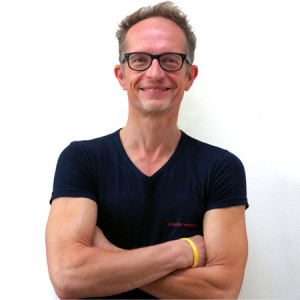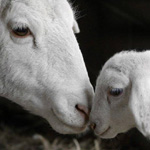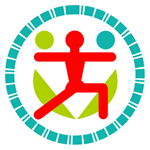Nutrition and me

As a child I have always had a great affinity with plants and animals. For that reason I wanted to study biology, but finally I went for a degree in agronomic engineering. At university in the mid eighties of the previous century the progressive words of the professor of ecology remained with me forever. He pointed out the tremendous wasting in meat production for food. But he remained rather a marginal exception with his speech. In most of the lessons it was all about financial benefits and production yields. Some professors, like the one who teached a course in cattle breeding, sometimes uttered true nonsense, like: “Eating meat? You have to do that in order to maintain your virility!”, in response to a rare question raised by a student with a critical mind. And that was by far not even the most stupid or erroneous thesis we got fed. Universities of applied science are domains where the mind is the sole ruler, one does not or only rarely raise questions on morals or ethics, let alone listens to the wisdom of the heart. I was no exception in those days, deeply sunken away in the sea of unconsciousness that is typical for a lot of people in their younger age.
Cooking came all by itself. Maybe because as a child in primary school I had to pick up my younger brothers and sister at their elementary school at noon, walk them home and then light the fire under my mother’s cooking pots. She came home from work to cook, and sometimes when she was late, I naturally learnt how long potatoes and vegetables had to be cooked in order to have them ready.
In our larger family, a great deal of the social interaction happened around the dinner table. When friends of my parents visited our home, or on the occasion of family reunions, is was very usual to sit for hours at the dinner table and to enjoy the abundant courses of carefully prepared traditional dishes. In Belgium, with its Burgundy style epicurist food culture this is very usual. My mother was and is still a devoted kitchen genius and her sister, who trained herself and acquired the skills of the traditional meat, fish and cream based French cuisine in the kitchens of renowned chefs, was a very talented cook.
I myself am not “haute cuisine” minded at all. Eating is one thing, but it is overvalued in our culture. It’s very twisted, actually. Here, eating has become synonymous with stuffing oneself, with keeping the stomach filled throughout the day while thoughts are being elsewhere. Being quietly and mindfully busy with preparing food is a skill we have lost in this mad society. How often a shop caddy is zombiewise filled to the brim with junk food that has been made by machines. Yoga invites us to simplicity and awareness.
And then there’s the animals.
Four scenes from my youth are forever burnt on the retina of my eyes.
The first: I was probably eight of nine. A sunny Sunday’s family excapade with a stop at the “commune van Latem”, aka the place where the cradle stood of what has in the meantime evolved into the health food company Lima. The soil was sandy and dusty over there, in Sint-Martens-Latem. My eye was captured by the scene of four older boys who were playing football. With a living toad. And none of the adults around even reacted. Something deep down in me got torn apart. Today, with the necessary distance, I realize I must have deeply felt that there was something profoundly wrong with the relationship between humans and nature, and between humans and animals in particular.
The second: I was twelve years old, and the family celebrated my solemn catholic communion. After the many courses, it was finally time for the dessert. I was called from the garden into the dining hall of the venue, because I was  supposed to cut the cake for the dessert. On a huge rectangular plate there was this snowy white ice cake upon which a kneeling lamb throned. A waiter gave me a big knife and made me understand that I had to cut off the head of the lamb, because then the blood, in the form of a jet of scarlet red grenadine, would flow out. I started to protest loudly because I felt a deep aversion to such blatant murderous symbolism. Finally I was forced to cut, as they wouldn’t let me spoil their party, but I missed and not a single drop flowed.
supposed to cut the cake for the dessert. On a huge rectangular plate there was this snowy white ice cake upon which a kneeling lamb throned. A waiter gave me a big knife and made me understand that I had to cut off the head of the lamb, because then the blood, in the form of a jet of scarlet red grenadine, would flow out. I started to protest loudly because I felt a deep aversion to such blatant murderous symbolism. Finally I was forced to cut, as they wouldn’t let me spoil their party, but I missed and not a single drop flowed.
The third: Somewhere between the age of eleven and fourteen as a young explorator at the boy scouts I witnessed an activity in the courtyard of our scouts quarters, during which a group of older explorators were about to kill with their own hands a defenceless rusty brown hen, probably to give proof of their courage with regard to their colleagues of the female guides who were present. I do not imagine how they finally killed the poor creature in their stupid clumsiness, because I was unable to watch the scene.
The fourth: It was at the end of the seventies, in the playground of my secondary school. It was the time of the “Games without Frontiers” television programmes, in which teams from different European countries were in competition in all kinds of rather idiotic games.
This concept was imitated during our school party, with mixed teams of pupils and teachers. In one of the game series two buckets were standing about ten meters away from each other. The aim of the game was to grab the living eels that were in the buckets, and to tranfer them as fast as possible into the other bucket. One French teacher, bent over the bucket when it was her turn and she petrified, she didn’t find it in her heart to grab the animals. She won my deepest sympathy forever.
With all that murderous symbolism and all that violent bandying about with animal life I instinctively felt from a very young age that there was something terribly wrong in the relationship and the way of cohabitation between human kind and the animal kingdom in this world.
During the first forty years of my life I ate meat, fish, eggs and dairy products just like everybody else. I was a devoted daily milk drinker and I was even proud of it! About ten years ago I decided to stop eating meat at first, and then also fish afterwards. I could not find one single rational argument to continue with it and so I became a ovo-lacto-vegetarian, which means someone who ate mainly plant based, with still dairy products and eggs.
In the month of April of 2012 something remarkable happened during a guided breathing meditation. I was lying on my back on the floor and I had the physical feeling that a kind of connection was all of a sudden created. For a moment it felt as if roots were growing from my heart through my back and my spine into the earth. I was overwhelmed by emotion, and it was so deep, as if in a fraction of a moment I was connected to all the sadness of this planet and all the living creatures, plants and animals, all the sorrow of the other earthlings that suffer under the cruel tyranny of a profoundly derailed human kind. I believe my heart must have opened in that fraction of a moment, or that I got in touch with the energy field of my heart. A connection was established. The magic of breathing.
Still it took me more than three months before I made the step towards veganism, at first hesitating, as a kind of temporary experiment, because, like so many other people I was drenched with the unconscious belief that skipping all proteins of animal origin would make all the flesh from my bones melt away in no time. I can testify today that all this is a myth, one of the many. Now that I can truly see that I am living in perfect health as a vegan during this last year, I find it totally inconceivable and absurd that even one more animal should be exploited or robbed of its life in order to supply me with food. The more I read and inform myself about the conditions in which farm animals have to live and die, the higher the fire of my motivation rises to share this with other people and to positively inspire them to make the transition to a sustainable meat and animal free diet. Meanwhile I am past fifty, and I believe I have found a meaningful purpose on which I want to spend the rest of my vital energy, and where my mind and heart both totally agree.
Where I am with my philosophy regarding food and eating, you can read on the page about The cooking philosophy of Yoga Kitchen.
Yoga and me – the bases (2003 – 2013)
I was never a sports-loving child. The competitive element of team sports, in which in essence the aim is to be the strongest or the fastest and to defeat an adversary, put me off completely. I hated the gym class at school, only Swedish style gymnastics somewhat pleased me, whereas the other guys in my class disliked the latter. In the eighties I was fascinated by the “Gym Tonic” sessions around noontime on one of the French television channels by two talkative French ladies. At home I was mocked by about everyone for this. It was also the era of Jane Fonda and the rise of aërobics. Once I went out of my parents’ house, I went to aërobics classes in my home town and I had the feeling I had finally found a sports dicipline that appealed to me, one without a hierarchy in which no opponent had to be crushed. In 1996 I bought a first book on the Iyengar Yoga method, but apart from the fact that I was mesmerized by the images in the book, it remained jobless on my shelf for years.
Until in 2003, during one of the many office jobs in my career, in which I had little more to do than to use my head and to remain nailed on a chair for the whole day, yoga lessons were offered by Hélène Petre during lunch time. Although the choice between eating lunch or practicing yoga was sometimes hard, I was totally amazed about the tremendous energy resources these simple yoga sessions provided me for the remaining afternoon.
Since then, I have kept on practicing yoga, first Hatha Yoga, then Kundalini Yoga with teachers such as Cristophe Degraeuwe (Sat Darshan Singh) and Carlos Arandia (Sat Sunder Singh). I’ve started to explore other yoga disciplines and following a series of workshops organized by Nicole Couloubaritsis in Brussels in 2012, I got in touch with Alberto Paganini and his Prana Yoga Flow style in Bruges, who finally gave me a solid base to start teaching basic classes. I got enthralled by the philosophy of non-violence out of the eightfold yoga path. It seemed I had found a blueprint of how I wanted to be in this world. I must also mention the incredible work of Isabelle Versé with the Transformational Breathing techniques, which is a big source of inspiration. And finally, Manon Weimar‘s zest for work and entrepreneurship in Holland is equally an inspiring example.
My yoga training is still ongoing and will probably last till the end of my life.
My experience in training and coaching and my presentation skills are of great help to my recent endeavors in the context of Yoga Kitchen.
Recent evolutions in yoga (2015 – 2018)
Yin yoga advanced
Although Alberto Paganini gave quite a good insight into the nature and specificity of Yin yoga during basic training, I took 50 training hours with Joe Barnett, both in March 2015 and in April, 2016. Joe Barnett is senoir studant and assistant of Paul Grilley, the American founder of Yin yoga. The first building block of Joe’s training will remain in my memory as truly transformative and trail-blazing with regards to the anatomical aspects of yoga. I would consider it a must for every yoga-teacher. Joe teaches with great generosity and a healthy sense of humour and succeeds brilliantly in rendering the subject “physionomical variations of the human body” crystal clear, both visually and tangibly.
Yoga for therapeutic purposes
At the end of 2015 I got in touch with Marc Beuvain, and in 2016 I took his eleven full days training course Therapeutic Yoga. Marc is a passionate and well-skilled trainer who teaches with razor sharp structural precision. He is somewhat an outsider in the yoga world. It was fascinating to see how on the one hand his teachings are based on his erudite knowledge of older yoga texts that precede all that is generally accepted and cited today as “the” sources of modernist neo-yoga. And on the other hand he gently strips yoga and the many yogic myths of their inflation, of their hollow and insignificant stereotypes and of all aspects that are irrelevant to our Western culture. Therefore, his eleven days’ cycle on yoga and therapy are very much “both feet on the ground” and an absolute must for anyone who wants more insight and practical scope when confronted with yoga students coping with injury or specific bodily situations.
Pranayama
In 2017 I took Marc Beuvain’s two days training on Pranayama.
Effective intuition
By the end of 2017 I enrolled for the first year of the “Effective intuition” (“Effectieve intuïtie”) in Haarlem, The Netherlands, at the Institute for Effective Intuition of Carolina Bont. It is my objective to be able to integrate the more subtle, energetic aspects of the chakra-system in the future in the yoga classes.
Peter Verhaegen, Brussels, December 2017.
Links:
- Hélène Petre: www.yogaetnature.be
- Alberto Paganini: www.yogasoma.be
- Isabelle Versé: www.innerjoypaths.com
- Cristophe Degraeuwe: http://yogabrasilia.org/sat-darshan-singh/ www.yogateachers4africa.com
- Carlos Arandia: www.wellness-brussels.com
- Nicole Couloubaritsis: www.galini-yoga.be
- Manon Weimar: www.vionte.nl
- Joe Barnett: www.joebarnettyoga.com
- Marc Beuvain: www.marcbeuvain.com
